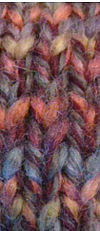- Gather (knitting)
-
In knitting, a gather is a generic term for the several methods that draw stitches closer together laterally, i.e., within a row of knitting. Common methods include:
- In binding, a yarn loop is passed over 2 or more stitches in the same row (usually adjacent to the binding loop); also known as a pullover stitch.
- In clustering, the yarn is wound laterally around a set of stitches in the same row, possibly several times; also known as a wrap stitch.
- Smocking is a sewing or embroidery technique in which the tiny pleats are drawn together with thread or yarn. Before the development of elastic, smocking was used to provide a stretchable, flexible panel of fabric.
Related techniques
In ruching, a large number of increases are introduced in one row, which are then removed by decreases a few rows later. This produces many small vertical ripples in the fabric, effectively little pleats. The technique of shirring produces a similar effect by gathering the fabric in two parallel rows (not necessarily horizontal), usually by smocking.
References
- Hiatt, June Hemmons (1988). The Principles of Knitting. Simon and Schuster. pp. 55–56, 82–83. ISBN 0-671-55233-3. OCLC 17325110.
Categories:- Knitting methods for shaping
- Textile arts stubs
Wikimedia Foundation. 2010.

